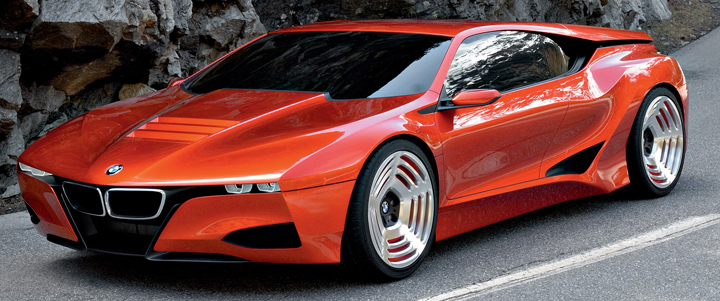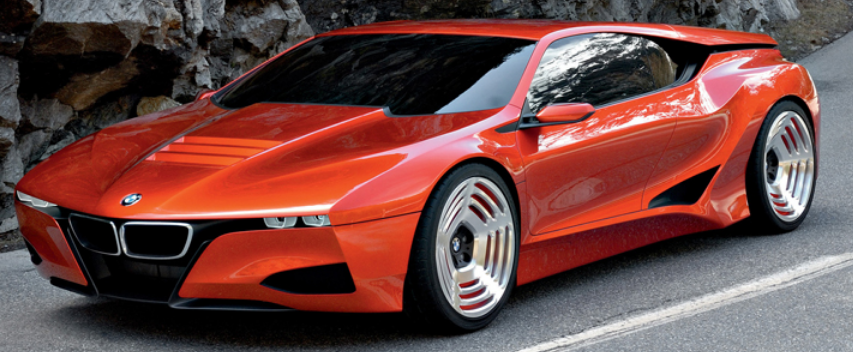
![]()
BMW may be the world’s top-selling premium vehicle brand, but it doesn’t have a supercar like German archrivals Audi (R8) and Mercedes-Benz (SLS AMG). That should change in 2016, when BMW is tipped to premiere a successor to its iconic mid-engine M1 of the late 1970s. One key difference: The new version will be sold as a convertible, not just a racy coupe.
BMW i8: A Sporty Spin on the Hybrid Formula
Supercars are never cheap, of course, and the new M1 will be no exception. Company sources suggest pricing will start at around $316,500—and that’s in today’s money.
This news comes from Britain’s CAR magazine, which notes that BMW is only getting started on the new M1, with many specifics still to be decided. Even so, reporter Georg Kacher has confirmed major elements of the likely design and engineering based on talks with various personnel at BMW’s M performance division, where the car is being developed.
For starters, the styling will likely be evolved from that of the 2008 M1 Homage concept coupe, which reinterpreted the original M1 design with a 21st century aesthetic. Expect a low-slung two-seater with complex lower-body surfaces and crisp feature lines, plus the classic-M1 signatures of a louvered hood and rear window, slim air vents in the rear roof pillars, and a BMW roundel badge above each taillamp. Proportions should be modern mid-engine supercar with a fairly short nose, a purposeful wheels-at-corners stance, and an arched roof line sweeping down to a cut-off tail. The Homage concept crouched ultra-low on relatively enormous wheels, but CAR’s speculative rendering, based on Kacher’s insider intel, suggests realistic ground clearance and rim diameter of 20-22 inches. Doors will be conventional, as on all current rivals bar the SLS gullwing coupe. No word yet on how the convertible will look, but weight and space considerations have planners leaning toward a fabric top instead of a hideaway metal cover.
Logic suggests the reborn M1 will have a new unibody structure shared with no other BMW, and will take advantage of weight-saving technology and materials developed for the company’s upcoming i8 plug-in-hybrid sports coupe. Kacher points to extensive use of carbon-fiber and aluminum in line with an unofficial curb-weight target of 2,755 pounds. If that’s achieved, he says, the new M1 would weigh a substantial 440 pounds less than a current Porsche 911 Carrera S and some 400 pounds less than the carbon-intensive McLaren MP4-12C. That means it would also weigh only 110 pounds more than the original M1 despite incorporating weighty measures to meet safety standards that didn’t exist over 30 years ago.
The Homage concept was sized much like the original M1, and we suspect the new production model will be too. That should mean length-width-height on the order of 172 x 75 x 45 inches over a 101-inch wheelbase, give or take an inch here and there. If we’re right, the new M1 would be a bit larger than the McLaren and a tad smaller than the Ferrari 458, another M Division target.
Both those cars use high-tune V8 engines to save weight and space. Kacher reports the new M1 will follow suit with a twin-turbo 4.0-liter engine sitting lengthwise behind the cockpit and tuned for 600 horsepower and possibly 650. Kacher says this V8 will boast several high-tech features including variable-length manifolds, adjustable camshafts, “different-size progressive-vane turbochargers, plus plenty of new lightweight [internal] materials with low-friction surfaces.” He also forecasts a new direct-injection system that can “dim” fuel delivery to improve mpg and emissions performance in much the same way as a cylinder-shutdown feature would. The transmission will be new too, Kacher says: “a fast-shifting dual-clutch gearbox with eight or nine forward ratios.”
BMW Brings i8 Concept (Plug-in Hybrid) and i3 Concept (Electric) to LA Auto Show
Like other modern supercars, the new M1 will maximize both efficiency and high-speed stability with “active aero” body features. Kacher says these will involve deformable grille-mounted air deflectors a la 458, movable inner-body flaps, and strategically placed ducts and vents. The aim is to reduce high-speed air drag and/or to generate added aerodynamic downforce (to keep the car better glued to the road).
With all this, the new-age M1 should be a tempting alternative to established supercars in both image and performance. Kacher says BMW insiders speak of a 206-mph top speed and three seconds flat from 0 to 62 mph. Munich’s new supercar may also prove more eco-conscious than comparable German and Italian rivals despite its prodigious power. As a senior M Division manager told CAR’s reporter, “If the i8 is the world’s sportiest green car, then our new mid-engined two-seater needs to be the greenest [conventional] sports car. . . . [It] won’t be as fast as a [Bugatti] Veyron . . . but it will be a real eye-opener in terms of ride, handling, performance and—above all—driveability.” The new M1 will need to be at least that, if not more, considering the caliber of its competition and that formidable price.
Before we go, a few words about the original M1 as historical context for the new one. It was conceived as BMW’s standard-bearer for international GT-class endurance racing in the late 1970s, but most of it was actually developed under contract by Italy’s Lamborghini, then a small independent concern (today it’s a somewhat larger enterprise owned by Volkswagen Group). Giorgetto Giugiaro’s ItalDesign contributed square-lined styling for the fiberglass body, so the car ended up looking more Italian than German. Racing rules required that at least 400 units be built for sale. Lamborghini was supposed to handle that too, but didn’t have the resources, so production was delayed until late 1978, when BMW arranged for the small Stuttgart-based Baur coachworks to do the deed.
The original M1 was produced in three forms. The “consumer” model carried a twincam 32-valve version of BMW’s contemporary 3.5-liter straight six, with 277 horsepower channeled through a 5-speed manual transaxle. Racing versions were developed with 470 horses or, via a turbocharged 3.2 engine, a very impressive 850, but the production delay prevented them from competing as planned. With its corporate pride wounded, BMW tried to salvage the situation by organizing the Procar racing series, in which top Formula One drivers and select privateers competed in presumably identical M1s as a “warmup” attraction to various Grand Prix contests in Europe. Unfortunately for BMW, interest soon waned in Procar and the M1 itself, and the project was wound down in 1981 after total production of 460 units.
But if not the racing success BMW had hoped for, the original M1 generated tons of favorable publicity as the brand’s first true supercar. More importantly, it gave impetus to formation of BMW Motorsport GmbH, the forerunner of today’s M Division, and its long skein of enthusiast-revered M3s, M5s, and M6s that remain the most visible symbols of the company’s “ultimate driving machine” ethos.



